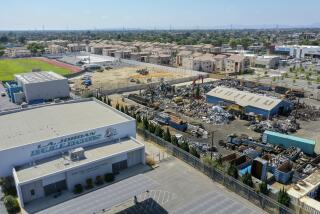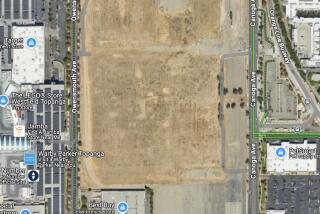Records Show Lab’s History of Destroying Waste : Disposal: Rockwell blew up explosive wastes for nearly 30 years with no government interference until 1989. However, two physicists’ deaths in 1994 have now raised questions.
Rockwell International, which government investigators have said might have been illegally disposing of explosive waste when two scientists were killed last year, had a nearly 30-year history of destroying explosive waste by blowing it up without opposition from government agencies, state records show.
Open burning and detonation were so routine at Rockwell’s Santa Susana Field Laboratory that the company explained how to do it in a safety manual, according to the records.
After regulators ordered an end to the practice in 1989 out of concern for air and ground-water pollution, the company applied for a permit to continue on-site burning in a thermal destruction unit. Rockwell withdrew the application in 1990, and later ran afoul of state toxic waste regulators, who cited the company for continuing to blow up explosive waste mixed with solvents, and for improperly storing excess propellant.
Executives with Rockwell’s Rocketdyne division said that company physicists Otto K. Heiney and Larry A. Pugh were conducting a scientific experiment--not destroying waste--when they died in the blast last summer at the lab west of Chatsworth. Federal criminal investigators are looking into whether the tests may have been a cover for illicit waste disposal.
From public records and interviews, this much is clear: Disposing of explosive waste had become a chronic headache for the company in the years leading up to the disaster. At the time of the accident, Rocketdyne had accumulated an explosives stockpile of nearly 7,000 pounds, according to state records, and was shopping the country’s explosive waste disposal services for a way to get rid of it, people in the industry say.
Disposing of explosive waste by blowing it up is certainly as old as the business of making rockets. State documents indicate that propellant and other explosives were being detonated or burned at Santa Susana by the early 1960s. Burning was common throughout the defense and aerospace industries, and the practice was defended as safer than transporting explosive waste on streets and highways.
But increasing environmental oversight put an end to the old way of doing things.
*
“As the years have gone by, there are fewer and fewer places where this material can go where it can be taken safely,” said Florence Gharibian of the state Department of Toxic Substances Control. “And as it gets older and older, it becomes less and less likely that it can be put to any beneficial use. So these contractors find themselves in a dilemma.”
The “burn pit,” as the disposal area was called, was created in 1958, according to a history of the site provided by Rockwell to the Los Angeles Regional Water Quality Board.
Propellant waste was destroyed there from the early 1960s, and until 1990, the site was used to blow up waste ranging from soiled gloves and paper towels to unused rocket fuel, according to state and company documents.
In 1974, the company sought and got permission from Ventura County authorities to burn waste on specified days. The company cited its agreement with Ventura County years later as it tried to persuade state regulators that on-site disposal of explosives was legal and should be allowed to continue.
But in 1989, the state ordered an end to open burning. Rocketdyne applied for a permit to continue burning in a thermal treatment unit in May, 1990, but withdrew the application six months later.
“We decided not to seek a permit for on-site disposal because shipment to permitted, off-site facilities was more practical,” the company told The Times in a written statement.
Burning continued through the fall of 1990, however, and the state accused the company of also blowing up solvents with explosive wastes. The state cited these explosions in a broader hazardous waste lawsuit against Rockwell that was settled in 1992 for about $650,000.
Since then there has been no indication that the burns continued, said Carla Slepak, the state toxics official responsible for permits at the Santa Susana site.
But the deaths of Pugh and Heiney on July 26, 1994, have raised questions.
The company said the men were killed during a test of “overpressure” waves emitted when different chemical mixtures explode.
According to reports on the accident, the men placed sawdust in an aluminum pan and then added nitrocellulose, gycidyl azide polymer and triamino guanidine nitrate, which they detonated with a remotely controlled electric match. They were mixing another batch when the pan blew up.
But the California Division of Occupational Safety and Health in a report on the incident said the procedure “did not resemble a typical test series for determining air overpressure from a detonation of propellant or explosives.” Further, the report said, “the manner in which the tests were set up and performed appeared to be a disguise for destroying waste explosive materials.”
Here is a description, from a 1984 Rockwell manual, of thermal treatment of explosive waste: “To effect the burning, the explosives shall be spread out in a longitudinally split 55-gallon drums [sic] to a continues [sic] thickness no greater than one inch mixed with sawdust and remotely ignited with an electric match or solid propellant lighter, from behind a proper barricade.”
In a memo two weeks after the 1994 blast, a Cal/OSHA official implied that Heiney and Pugh were blowing up waste materials drawn from a 6,955-pound stockpile that was “awaiting proper environmental disposal.”
“The materials were used in this instance due to their availability,” Cal/OSHA safety engineer Barry Blodgett said in the Aug. 8, 1994, memo.
But in terse, written responses to questions from The Times, Rocketdyne officials disputed the notion that the compounds described in the Blodgett memo were wastes--a key legal distinction because Rocketdyne could store chemical inventories indefinitely but lacked a state permit to store explosive wastes.
“We do not agree that these materials were wastes,” the company said. Nonetheless, Rocketdyne said Friday, all 6,955 pounds have “been removed or properly disposed of” in the 11 months since the Blodgett memo. Citing the pending criminal probe by the FBI and other agencies, company officials declined to elaborate on any of their responses.
Interviews with people in the waste disposal business indicate that Rocketdyne was shopping the waste disposal industry before and after the accident, contacting the three major U.S. commercial explosives disposal sites.
Jim Gallion, facilities manager for Laidlaw Environmental Services Thermal Treatment in Colfax, La., said the firm gave Rocketdyne information on Laidlaw’s services in May, 1994, and again in July a couple of weeks before the fatal accident.
More to Read
Inside the business of entertainment
The Wide Shot brings you news, analysis and insights on everything from streaming wars to production — and what it all means for the future.
You may occasionally receive promotional content from the Los Angeles Times.










